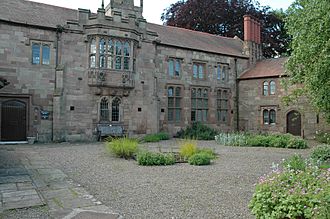Monmouth Priory facts for kids
Quick facts for kids Monmouth Priory |
|
|---|---|

The Priory, showing the oriel window
|
|
| General information | |
| Type | Benedictine priory |
| Address | Priory Street |
| Town or city | Monmouth |
| Country | Wales |
| Coordinates | 51°48′48.8″N 2°42′50.9″W / 51.813556°N 2.714139°W |
| Renovated | 2002 |
| Renovating team | |
| Architect | Keith Murray |
Monmouth Priory, located on Priory Street in Monmouth, Wales, is a special building. It includes parts of the old monastery buildings that were once connected to St Mary's Priory Church. The priory was founded by Benedictine monks in 1075. Some parts of these very old buildings are still standing today.
In the 1800s, the buildings were greatly changed to become St Mary's National School. Now, Monmouth Priory is a busy community centre. It is a Grade II* listed building, which means it's a very important historic site. The Priory is also one of 24 interesting places you can visit on the Monmouth Heritage Trail.
Contents
History of Monmouth Priory
The priory was started by a man named Withenoc in 1075. He was from Brittany and became the lord of Monmouth that year. There are signs that an even older Celtic church might have been on this spot in the 700s.
The priory was given to the Abbey of St Florent in Saumur, France. It was officially opened in 1101. Later in the 1100s, the priory church became bigger and started serving as the main church for the local area. In 1536, the priory was closed down during a time called the Dissolution of the Monasteries.
The monastery buildings were on the north side of the priory church. In 1906, when the Baptist Church was being built, people found traces of an old hospital. The buildings that are still standing today were once where the prior (the head monk) lived.
One special old feature is a beautiful window from the mid-1400s. It's called an "oriel window" and it sticks out from the building. Many people mistakenly think it's connected to Geoffrey of Monmouth, who lived much earlier. This window was probably part of the priory's gatehouse.
The window has three carved heads underneath it. These carvings are very detailed. People aren't completely sure what they show. Some think they are an angel, a regular person, and a bedesman (someone who prays for others). Others believe they show a knight, an angel, and a miller.
The prior's home was made larger several times in the 1800s when it was used as St Mary's National School.
Modern Restoration and Use
The building was carefully restored with money from the Heritage Lottery Fund. An architect named Keith Murray planned the work, which finished in 2002. Today, Monmouth Priory is a community centre. People can use it for many different events like weddings, meetings, and art shows.
The Geoffrey Tapestry
In December 2000, someone suggested creating a large wallhanging to tell the story of Geoffrey of Monmouth. It took six months to research, design, and get ready for the project. The first stitches were made in July 2001, during the celebrations for the Priory's 900th anniversary.
The wallhanging measures about 1.5 metres (5 feet) by 1.6 metres (5.2 feet). It was finished in May 2003. Fourteen volunteers worked together for a total of 2,750 hours to create it.
The background design of the tapestry is based on a stained glass window in St Mary's Priory Church, Monmouth. This window is called ‘The Four Rivers Window’. A Celtic knot pattern slowly rises from green (earth) to blue (sky) and then to purple (heaven). These twisting lines were also used by artists from Hereford who worked on the Priory in the late 1000s. A beaded pattern from one of the old stone carvings is used in the lower parts of the background.
There are three embroidered "windows" within the tapestry. The middle one shows Geoffrey of Monmouth. He is wearing the black robes of the Benedictine monks. King Arthur and Queen Guinevere are shown being crowned at Caerleon by Dubricius. The River Usk in this scene matches the river theme of the 1800s stained glass window.
The Monnow and the Usk rivers connect with the River Wye in the third panel. In this scene, King Vortigern is listening to the young Merlin. Merlin is telling him the legend of the red and white dragons. Vortigern was a lord of Gwent. Legend says he was eventually killed at Ganarew, above the Wye Valley.
Three round designs connect the embroidered panels to the background. Below Geoffrey is the head of the angel that is carved outside, under "Geoffrey's Window." Below Arthur is his shield, "Pridwen," which has an image of the Virgin Mary. His sword, "Caliburn," can be seen in the first letter 'A'. Finally, the red and white dragons are found in the Vortigern panel.
Images for kids





